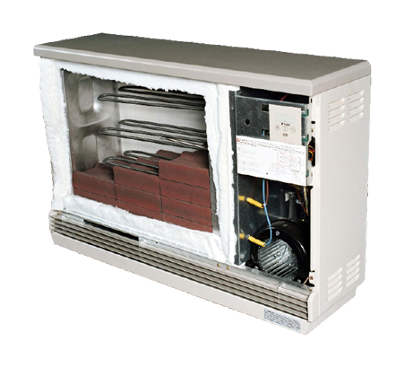ACEP, UAF Awarded $2.5 M to Study Alternative Heat to Reduce PM2.5

A new federally funded project will study whether an alternate electric heat source can help reduce particulate air pollution in the Fairbanks North Star Borough.
The effort, led by a University of Alaska Fairbanks research team, could help cut PM2.5 levels in the area. The U.S. Environmental Protection Agency has said fine particulates in Fairbanks air must be reduced to protect residents' health. The particulates often exceed federal standards during the winter.
Researchers plan to install electric thermal storage heaters in 50 homes with wood stoves in North Pole's Hurst Road area. Since firewood is the largest source of PM2.5 in the borough, the study will focus on whether displacing its use will make a significant difference in particulate pollution. Homeowners who volunteer to use the thermal heaters will receive a subsidized electric rate to encourage them to use the alternate heating source.
Air-quality measurements will be compared from before and after the installations, and a series of surveys will be conducted to collect information on home heating preferences and costs. Researchers will use that data to forecast how an increase in the use and concentration of electric thermal storage heaters will impact the borough’s air quality and home heating costs.
The National Science Foundation is funding the four-year project with a $2.9 million grant from its Navigating the New Arctic program.
“I think the project can provide some really useful applied information,” said Dominique Pride, a research assistant professor at UAF’s Alaska Center for Energy and Power. “We’re not trying to take stoves away. We’re not trying to get people to stop burning wood completely. We’re just trying to see if this is an acceptable way to address PM2.5 in the borough.”
Electric thermal storage heaters consist of an electric resistance heating element used to heat ceramic bricks enclosed in insulated box. As the bricks heat up, they serve as thermal storage. Fans blow air across the hot bricks, heating the air, which then enters the home, providing on-demand space heating.
The technology has been used in the United Kingdom and Europe since the 1940s, said Srijan Aggarwal, a UAF associate professor of environmental engineering who is part of the study. More recently, communities in the Yukon-Kuskokwim Delta have begun using excess electricity from wind installations to charge residential electric thermal storage heaters at a discounted rate.
If the heaters can help reduce particulate pollution in the Fairbanks area, they could be another tool that allows the borough to comply with EPA air-quality mandates, Aggarwal said.
“We want to see if this will work,” he said. “It’s worked as a heat source in other places in Alaska, and we want to know if it will work here to help with PM2.5.”
Other participants in the project, which will begin on Sept. 1, include Jan Dawe, the director of UAF’s OneTree Alaska, Northern Arizona University and Texas Tech University.
For more information contact Dominique Pride at djpride@alaska.edu.
Electric thermal storage stoves similar to this one will be installed in 50 homes in the Hurst Road area of North Pole as part of this study.



